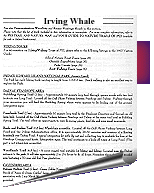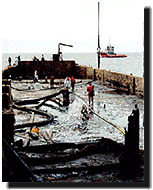
 Perhaps
one of the most spectacular environmental issues in
recent Prince Edward Island history has been the question
of the Irving Whale; a barge that sank about 60
kilometres northeast of North Point, Prince Edward Island
in the Gulf of St. Lawrence. The vessel was built in 1966
at the Saint John Shipbuilding and
Perhaps
one of the most spectacular environmental issues in
recent Prince Edward Island history has been the question
of the Irving Whale; a barge that sank about 60
kilometres northeast of North Point, Prince Edward Island
in the Gulf of St. Lawrence. The vessel was built in 1966
at the Saint John Shipbuilding and
Dry Dock Co., Ltd. for J. D. Irving Limited of Saint
John, New Brunswick.
When the barge went down in rough seas on September 7, 1970, it contained about 4,200 imperial tons of Bunker “C” oil in all eight of its tanks. During the two days following its sinking, the Irving Whale leaked oil covering an estimated 400 square kilometres. Approximately 200 imperial tons of oil washed onto the shores of the Iles-de-la-Madeleine, soiling 80 kilometres of shoreline. More oil made its way through the Cabot Strait and into the Atlantic Ocean. During the cleanup operation 25 years later, 200,000 bags of oil debris were recovered from the dunes of the Iles-de-la-Madeleine.
In 1970, Environment Canada conducted a visual
inspection of the barge and attempted to repair small
leaks from cargo tank vents and pressure relief valves.
The Canadian Coast Guard began regular aircraft and
surface surveillance of the site to check for pollution.
In 1989 and 1990, Transport Canada conducted a detailed
survey using divers and remote-operated vehicles. These
inspections confirmed that 16 cargo vents were leaking
oil, sometimes at a rate of 80 litres per day.
Furthermore, the thickness of the hull plating had
diminished by 5 percent. In 1993, divers reinforced the
cargo tank hatches and covered and sealed the 16 vents to
stop the flow of oil. However, a year later, 3 of the 16
vents were leaking again. 
After five years, several studies and numerous reports, the federal departments of Transport and Environment announced that they would lift the sunken barge from the floor of the Gulf. This period saw substantial and heated debate about the environmental risks associated with the Irving Whale. Some preferred the option of pumping the oil on site while others advocated lifting the barge with the oil on board. Environmental organizations across Canada and Prince Edward Island were quite vocal in their concerns about the implications of the Irving Whale.
The final decision was announced on August 5, 1994, to lift the barge, transport it to Mulgrave, Nova Scotia, recover the Bunker “C” oil, and clean and sell or dispose of the barge in an environmentally safe manner. At this point, the Canadian Coast Guard created Public Advisory Committees across Prince Edward Island and in the Iles-de-la-Madeleine. The committees were made up of representatives from community groups such as fishers’ organizations, tourism associations, environmental groups, provincial government departments, municipalities, etc.
On July 6, 1995, the issues
surrounding the Irving Whale achieved a new
level of urgency;  the federal government announced the
presence of 7.2 imperial tons of Polychlorinated biphenyl
(PCBs) in the wreck’s heating system. It was
revealed a month later that PCBs had been found in the
debris buried in the Iles-de-la-Madeleine in 1970.
Shortly thereafter, La société pour vaincre la
pollution inc. and Le regroupement madelinot
pour la protection du golfe, inc. filed a federal
court injunction to stop lifting the barge. A
month’s stay in the decision to proceed with the
lift caused the operation to be deferred to the summer of
1996. Further environmental assessments and debate,
public reviews, and consultations explored the
consequences of lifting the barge in light of the
presence of PCBs.
the federal government announced the
presence of 7.2 imperial tons of Polychlorinated biphenyl
(PCBs) in the wreck’s heating system. It was
revealed a month later that PCBs had been found in the
debris buried in the Iles-de-la-Madeleine in 1970.
Shortly thereafter, La société pour vaincre la
pollution inc. and Le regroupement madelinot
pour la protection du golfe, inc. filed a federal
court injunction to stop lifting the barge. A
month’s stay in the decision to proceed with the
lift caused the operation to be deferred to the summer of
1996. Further environmental assessments and debate,
public reviews, and consultations explored the
consequences of lifting the barge in light of the
presence of PCBs.
The Irving Whale Recovery Operation was finally launched on June 30, 1996, and completed on Thursday, August 8, when the Irving Whale was successfully towed to Halifax in a semi-submersible barge, the Boabarge 10. By April 1996, the barge, called “a ticking time bomb” by then Environment Minister Sergio Marchi, had leaked 1,100 imperial tons of Bunker “C” oil as well as PCBs into the Gulf of St. Lawrence.
Erosion | Soil Conservation | Ground Water Quality |
Surface Water Quality | Forestry Practices | Natural Disasters